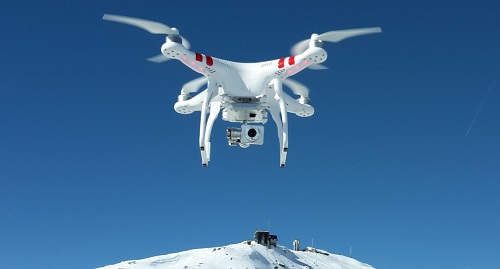In December last year, a privately owned aerial drone crashed into the grille of a moving vehicle in Belleville, Ont. The collision caused some $1,000 in damage, luckily no one was injured or killed, but it’s just one more reason why drone insurance could be a burgeoning area for insurance companies.
One such company that sees promise in the space is Intact Insurance. The firm announced this week the launch of a drone insurance specifically designed for commercial businesses. The company claims its UAV (unmanned air vehicle) coverage is a leading product insurance product that caters to small and medium-sized businesses that use or plan to use drones for their business.
“The number of businesses using drones is increasing due to improving technology, lower price points, and expanded uses within commercial operations,” Alain Lessard, senior vice-president, commercial lines for Intact, said in a statement. “Broker feedback and survey insights identified a growing customer demand and a gap in non-specialty markets for this type of coverage.”
He said Intact is confident their product will “help address current and future market demands.”
According to Intact, most drone operators typically need insurance against physical damage to people and property.
UAV coverage is the latest addition to Intact’s line of products and services. Other recent innovative commercial initiatives launched include its cyber endorsement, which protects businesses against cyber risks and myFleet Solution, a unique fleet-management insurance solution for businesses with fleets.
Intact is not the only company in Canada offering drone insurance.
Last year, Zurich Canada launched its own drone insurance packaged developed in partnership with the UK-headquartered Global Aerospace Underwriting Managers Ltd.
Zurich’s drone insurance policy provides companies with both first and third-party coverage for a variety of risks:
- First-party property coverage – for theft or damage to the drone and any ground equipment used to operate it, or any electronics or components (payload) carried.
- Third-party liability coverage – for property damage and bodily injury caused by the drone, premises liability at locations used in connection with scheduled aircraft, as well as medical expenses.
- Additional coverage extensions may include – malicious damage, system hacking, and personal injury
Previously limited to military use, drones are now increasingly being flown for commercial purposes. While relatively still in its infancy the global drone market, according to aerospace market analyst firm Teal Group, is projected to grow to US$11.5 billion by 2024.
Commercial UAVs can now be easily acquired at a modest cost, particularly when compared to manned aircraft, according to a litigation and dispute resolution bulletin from law firm Fasken.
Drones are being used for various commercial applications including surveillance, construction, agriculture, resource exploration, meteorology, mapping and photography.
“The growth of UAV use in the public realm has not been without issue,” the firm said. “…While there, fortunately, have been no aviation accidents to date, the risk of a collision between an aircraft and a UAV remains. There have also been a number of incidents involving recreational and commercial UAVs crashing in populated areas, damaging property and injuring people.”
Aviation is probably the most regulated industry in the world for security and safety reasons. In this space, drones are an anomaly because for now, in many jurisdictions, their use is guided by recommendations and general principles rather than laws.
Last year Transport Canada adopted new regulations for drones. Among the provisions was the requirement that commercial operators of drone weighing under 25 kilograms were exempted from obtaining a permit called the Special Flight Operations Certificates (SFOCs). Fines for violations range from $3,000 to $25,000.
The guidelines also state that no drones can be flown within nine kilometres of forest fires, airports or built-up areas and that drones cannot be flown higher than 90 metres, over a military base, prisons crowds or restricted airspace.
The unmanned aircraft industry has grown exponentially over the last few years. In 2012, Transport Canada issued 345 SFOCs for drone operators. That number has soared to 1,672 last year.
Since 2010, the department has investigated 50 incidents involving unmanned aircraft across Canada.
Transport Canada is working on new rules governing the use of drones and has proposed some amendments to existing regulations. Read those proposals by clicking on this link.
Transport Canada is also working with the Office of the Privacy Commissioner of Canada to flesh out issues concerning privacy.

